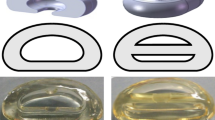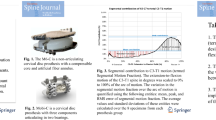Abstract
Purpose
The purpose of the study is to examine the biomechanical alterations in the index and adjacent levels of the human cervical spine after cervical arthroplasty with Bryan, Prodisc C, or Prestige LP.
Methods
A previously validated C2–T1 osteoligamentous finite element model was used to perform virtual C5–6 arthroplasty using three different FDA-approved artificial cervical discs. Motion-controlled moment loading protocol was used. Moment was varied until Bryan, Prodisc C, and Prestige LP models displayed the same total range of motion across C3–C7 as the intact spine model at 2 Nm of pure moment loading. Range of motion (ROM) and facet force (FF) were recorded at the index level. ROM, FF, and intradiscal pressure (IDP) were recorded at the adjacent levels.
Results
Prodisc C and Prestige LP led to supraphysiologic ROM and FF at the index level while decreasing ROM and FF at the adjacent levels. In contrast, Bryan reduced ROM and FF at the index level. Bryan increased ROM and FF at the adjacent levels in flexion, but decreased ROM and FF in the adjacent levels in extension. Prodisc C decreased IDP at the adjacent levels. Bryan reduced IDP in extension only. Prestige LP increased adjacent-level IDP.
Conclusions
The distinct designs and material compositions of the three artificial discs result in varying biomechanical alterations at the index and adjacent levels in the cervical spine after implantation. The findings confirm the design and material influence on the spine biomechanics, as well as the advantages and contraindications of cervical arthroplasty in general.
Graphic abstract
These slides can be retrieved under Electronic Supplementary Material.






Similar content being viewed by others
Abbreviations
- ACDF:
-
Anterior cervical discectomy and fusion
- ROM:
-
Range of motion
- IDP:
-
Intradiscal pressure
- FF:
-
Facet force
- FEM:
-
Finite element modeling
References
Xu JC, Goel C, Shriver MF, Tanenbaum JE, Steinmetz MP, Benzel EC, Mroz TE (2018) Adverse events following cervical disc arthroplasty: a systematic review. Glob Spine J 8(2):178–189. https://doi.org/10.1177/2192568217720681
Chang UK, Kim DH, Lee MC, Willenberg R, Kim SH, Lim J (2007) Range of motion change after cervical arthroplasty with ProDisc-C and prestige artificial discs compared with anterior cervical discectomy and fusion. J Neurosurg Spine 7(1):40–46. https://doi.org/10.3171/SPI-07/07/040
Chen WM, Jin J, Park T, Ryu KS, Lee SJ (2018) Strain behavior of malaligned cervical spine implanted with metal-on-polyethylene, metal-on-metal, and elastomeric artificial disc prostheses—a finite element analysis. Clin Biomech (Bristol, Avon) 59:19–26. https://doi.org/10.1016/j.clinbiomech.2018.08.005
Galbusera F, Anasetti F, Bellini CM, Costa F, Fornari M (2010) The influence of the axial, antero-posterior and lateral positions of the center of rotation of a ball-and-socket disc prosthesis on the cervical spine biomechanics. Clin Biomech (Bristol, Avon) 25(5):397–401. https://doi.org/10.1016/j.clinbiomech.2010.01.010
Galbusera F, Fantigrossi A, Raimondi MT, Sassi M, Fornari M, Assietti R (2006) Biomechanics of the C5–C6 spinal unit before and after placement of a disc prosthesis. Biomech Model Mechanobiol 5(4):253–261. https://doi.org/10.1007/s10237-006-0015-4
Gandhi AA (2012) Biomechanical analysis of the cervical spine following total disc arthroplasty: an experimental and finite element investigation. University of Iowa, Iowa City
Gandhi AA, Kode S, DeVries NA, Grosland NM, Smucker JD, Fredericks DC (2015) Biomechanical analysis of cervical disc replacement and fusion using single level, two level, and hybrid constructs. Spine (Phila Pa 1976) 40(20):1578–1585. https://doi.org/10.1097/BRS.0000000000001044
Hu N, Cunningham BW, McAfee PC, Kim SW, Sefter JC, Cappuccino A, Pimenta L (2006) Porous coated motion cervical disc replacement: a biomechanical, histomorphometric, and biologic wear analysis in a caprine model. Spine (Phila Pa 1976) 31(15):1666–1673. https://doi.org/10.1097/01.brs.0000224537.79234.21
Jung TGW, Woo SH, Park KM, Jang JW, Han DW, Lee SJ (2013) Biomechanical behavior of two different cervical total disc replacement designs in relation of concavity of articular surfaces: prodisc-C versus prestige-LP. Int J Precis Eng Manuf 14(5):819–824
Kang H, Park P, La Marca F, Hollister SJ, Lin CY (2010) Analysis of load sharing on uncovertebral and facet joints at the C5–6 level with implantation of the Bryan, Prestige LP, or ProDisc-C cervical disc prosthesis: an in vivo image-based finite element study. Neurosurg Focus 28(6):E9. https://doi.org/10.3171/2010.3.FOCUS1046
Li Y, Zhang Z, Liao Z, Mo Z, Liu W (2017) Finite element analysis of influence of axial position of center of rotation of a cervical total disc replacement on biomechanical parameters: simulated 2-level replacement based on a validated model. World Neurosurg 106:932–938. https://doi.org/10.1016/j.wneu.2017.07.079
Lin CY, Kang H, Rouleau JP, Hollister SJ, Marca FL (2009) Stress analysis of the interface between cervical vertebrae end plates and the Bryan, Prestige LP, and ProDisc-C cervical disc prostheses: an in vivo image-based finite element study. Spine (Phila Pa 1976) 34(15):1554–1560. https://doi.org/10.1097/BRS.0b013e3181aa643b
Tan QC, Feng YF, Zhang Y, Wu ZX, Ma ZS, Sang HX, Yan YB, Lei W, Zhao X (2015) A novel total cervical prosthesis for single-level cervical subtotal corpectomy: radiologic and histomorphometric analysis in a caprine model. J Spinal Disord Tech 28(3):E166–172. https://doi.org/10.1097/BSD.0000000000000202
Helgeson MD, Bevevino AJ, Hilibrand AS (2013) Update on the evidence for adjacent segment degeneration and disease. Spine J 13(3):342–351. https://doi.org/10.1016/j.spinee.2012.12.009
Moatz B, Tortolani PJ (2012) Cervical disc arthroplasty: Pros and cons. Surg Neurol Int 3(Suppl 3):S216–224. https://doi.org/10.4103/2152-7806.98582
Ren C, Song Y, Xue Y, Yang X (2014) Mid- to long-term outcomes after cervical disc arthroplasty compared with anterior discectomy and fusion: a systematic review and meta-analysis of randomized controlled trials. Eur Spine J 23(5):1115–1123. https://doi.org/10.1007/s00586-014-3220-3
ASTM (2006) Standard guide for functional, kinematic, and wear assessment of total disc prostheses. ASTMF2423–05
de Jongh CU, Basson AH, Scheffer C (2008) Predictive modelling of cervical disc implant wear. J Biomech 41(15):3177–3183. https://doi.org/10.1016/j.jbiomech.2008.08.025
ISO (2005) Implants for surgery—wear of total intervertebral spinal disc prostheses—part 1: loading and displacement parameters for wear testing and corresponding environmental conditions for tests. ISO/DIS 18192–1
Bhattacharya S, Goel VK, Liu X, Kiapour A, Serhan HA (2011) Models that incorporate spinal structures predict better wear performance of cervical artificial discs. Spine J 11(8):766–776. https://doi.org/10.1016/j.spinee.2011.06.008
Yeh CH, Hung CW, Kao CH, Chao CM (2014) Medium-term outcomes of artificial disc replacement for severe cervical disc narrowing. J Acute Dis 3(4):290–295
John JD, Saravana Kumar G, Yoganandan N (2019) Cervical spine morphology and ligament property variations: a finite element study of their influence on sagittal bending characteristics. J Biomech 85:18–26. https://doi.org/10.1016/j.jbiomech.2018.12.044
Arun MW, Yoganandan N, Stemper BD, Zheng M, Masoudi A, Snyder B (2014) Sensitivity and stability analysis of a nonlinear material model of cervical intervertebral disc under cyclic loads using the finite element method. Biomed Sci Instrum 50:19–30
Wheeldon JA, Stemper BD, Yoganandan N, Pintar FA (2008) Validation of a finite element model of the young normal lower cervical spine. Ann Biomed Eng 36(9):1458–1469. https://doi.org/10.1007/s10439-008-9534-8
Wheeldon JA, Pintar FA, Knowles S, Yoganandan N (2006) Experimental flexion/extension data corridors for validation of finite element models of the young, normal cervical spine. J Biomech 39(2):375–380. https://doi.org/10.1016/j.jbiomech.2004.11.014
Bell KM, Yan Y, Hartman RA, Lee JY (2018) Influence of follower load application on moment-rotation parameters and intradiscal pressure in the cervical spine. J Biomech 76:167–172. https://doi.org/10.1016/j.jbiomech.2018.05.031
Patel VV, Wuthrich ZR, McGilvray KC, Lafleur MC, Lindley EM, Sun D, Puttlitz CM (2017) Cervical facet force analysis after disc replacement versus fusion. Clin Biomech (Bristol, Avon) 44:52–58. https://doi.org/10.1016/j.clinbiomech.2017.03.007
Wang Z, Zhao H, Liu JM, Tan LW, Liu P, Zhao JH (2016) Resection or degeneration of uncovertebral joints altered the segmental kinematics and load-sharing pattern of subaxial cervical spine: A biomechanical investigation using a C2–T1 finite element model. J Biomech 49(13):2854–2862. https://doi.org/10.1016/j.jbiomech.2016.06.027
Mercer S, Bogduk N (1999) The ligaments and annulus fibrosus of human adult cervical intervertebral discs. Spine (Phila Pa 1976) 24(7):619–626; discussion 627–618
Kumaresan S, Yoganandan N, Pintar FA, Macias M, Cusick JF (2000) Morphology of young and old cervical spine intervertebral disc tissues. Biomed Sci Instrum 36:141–146
Kumaresan S, Yoganandan N, Pintar FA, Maiman DJ (1999) Finite element modeling of the cervical spine: role of intervertebral disc under axial and eccentric loads. Med Eng Phys 21(10):689–700
Panjabi MM (2007) Hybrid multidirectional test method to evaluate spinal adjacent-level effects. Clin Biomech (Bristol, Avon) 22(3):257–265. https://doi.org/10.1016/j.clinbiomech.2006.08.006
Liao Z, Fogel GR, Wei N, Gu H, Liu W (2015) Biomechanics of artificial disc replacements adjacent to a 2-level fusion in 4-level hybrid constructs: an in vitro investigation. Med Sci Monit 21:4006–4014
Choi H, Baisden JL, Yoganandan N (2019) A Comparative in vivo study of semi-constrained and unconstrained cervical artificial disc prostheses. Mil Med 184(Suppl 1):637–643. https://doi.org/10.1093/milmed/usy395
Hacker FM, Babcock RM, Hacker RJ (2013) Very late complications of cervical arthroplasty: results of 2 controlled randomized prospective studies from a single investigator site. Spine (Phila Pa 1976) 38(26):2223–2226. https://doi.org/10.1097/BRS.0000000000000060
Byeon JH, Kim JW, Jeong HJ, Sim YJ, Kim DK, Choi JK, Im HJ, Kim GC (2013) Degenerative changes of spine in helicopter pilots. Ann Rehabil Med 37(5):706–712. https://doi.org/10.5535/arm.2013.37.5.706
Acknowledgements
This material is the result of work supported by the U.S. Department of Defense, Medical Research and Materiel Command, Grant W81XWH-16-1-0010, with the resources and use of facilities at the Zablocki VA Medical Center, Milwaukee, Wisconsin, and the Center for NeuroTrauma Research (CNTR) from the Department of Neurosurgery. The last author is a part-time employee of the VA Medical Center, Milwaukee, Wisconsin. Any views expressed in this article are those of the authors and not necessarily representative of the funding organizations.
Author information
Authors and Affiliations
Corresponding author
Ethics declarations
Conflict of interest
The authors declare that they have no conflict of interest.
Additional information
Publisher's Note
Springer Nature remains neutral with regard to jurisdictional claims in published maps and institutional affiliations.
Electronic supplementary material
Below is the link to the electronic supplementary material.
Rights and permissions
About this article
Cite this article
Choi, H., Purushothaman, Y., Baisden, J. et al. Unique biomechanical signatures of Bryan, Prodisc C, and Prestige LP cervical disc replacements: a finite element modelling study. Eur Spine J 29, 2631–2639 (2020). https://doi.org/10.1007/s00586-019-06113-y
Received:
Revised:
Accepted:
Published:
Issue Date:
DOI: https://doi.org/10.1007/s00586-019-06113-y




